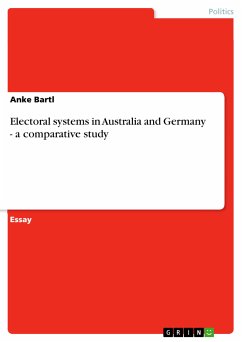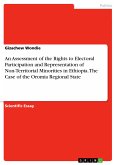Essay from the year 2003 in the subject Politics - Region: Australia, New Zealand, grade: Distinction, Flinders University (Social Sciences), course: Australian Politcs a comparative study, language: English, abstract: This essay aims to explain the differences between preferential and proportional systems of voting and the consequences of these systems in Australia. The electoral system of Germany is examined in comparison. Why are electoral systems so important? Through elections, citizens of a county can express their views and choose the government they wish to see in power. Therefore, the electoral system is one of the significant features of a democracy and a representative government. The political outcome of an election can vary greatly depending on which of the different types (and/or variations of each type) of systems is in effect. Hence, the organisation of the political system strongly depends on the electoral system.1 The impacts of electoral systems on the political and party system will be examined after looking at the two systems of voting used in Australia at the Commonwealth/ Federal level: the preferential voting system and the system of proportional representation. Preferential voting in single-member seats is used for elections for the House of Representatives and is also often referred to as Alternative Vote.2 A distinctive feature of this voting system is that the winning candidate needs to receive an absolute majority of the primary vote, in other words 50% plus one. Alternatively, the candidate can win the election by securing an absolute majority after the distribution of preferences. 3 Under a system of full preferential voting, electors must indicate a preference for all candidates listed on the ballot paper. Voters show their first preference by giving the number “1” to their preferred candidate. They then rank all other candidates by distributing the remaining numbers in descending order from 2 to X (X = the number of candidates taking part in the election). In the first round of counting votes, the numbers of primary votes are registered. [...] 1 David W. Lovell et al., The Australian Political System, (2nd edition), Longman, South Melbourne, 1998, p. 269. 2 Ben Reilly, ‘The Alternative Vote in Australia’, 6 March 1999, Electoral Systems, Administration and Cost of Elections Project,
Bitte wählen Sie Ihr Anliegen aus.
Rechnungen
Retourenschein anfordern
Bestellstatus
Storno









